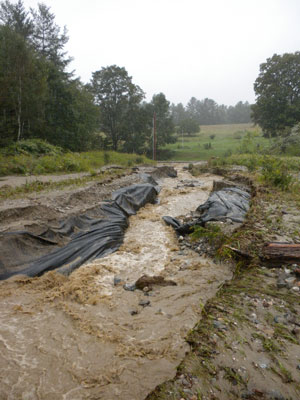
The driveway to my house, in Ludlow near the Plymouth town border, became a river during Tropical Storm Irene.
I have to admit that all of the rain we’ve gotten lately has made me very nervous. As a Tropical Storm Irene victim, I am paying particularly close attention to the flash flood warnings that scroll across my television screen. I also keep checking and re-checking the culverts near my house to make sure there is nothing clogging them up.
Driving home from the VCRD office in the middle of a rain storm last week, I got an arresting alert piped into my car stereo from my cell phone, thanks to my regular Bluetooth connection. It certainly got my undivided attention! Since I had never received an alert like that before and had not signed up for any, I couldn’t resist making a few calls to find out more about this new alert system and why it found its way onto my cell phone. Enter Jason Gosselin, Operations and Logistics Chief at the Vermont Division of Emergency Management and Homeland Security (DEMHS), who was more than happy to break it down for me so that I could explain it here.
According to Gosselin, the DEMHS will be implementing a new notification system by the end of this summer called Vermont Alert, or VTAlert for short. This system is presently in beta mode and is based on the same notification system used in New York State called NYAlert. Vermont’s system has been under development for about two years, while the NY model has been in action and making a difference in emergency preparedness for many years.
According to official documentation on the Vermont beta system available online, “VTAlert is part of the Vermont Government’s ongoing commitment to provide Vermonters with information so they understand the risks and threats that they may face and know how to respond accordingly. Each of us has the responsibility to be as prepared as possible for any emergencies that may arise. One of the keys to preparedness is having up-to-date information.”
I like the sound of that. Furthermore, Gosselin explained to me that there are two methods to get alerts from the system. When fully implemented at the end of summer, one can go to http://www.vtalert.gov/ and sign-up for alerts and self-select for different kinds of notifications, including cell phones, pagers, emails, and even message delivery to a family WII or X-Box.
The second way to get an alert is what happened to me. If there is an event that is significant enough – whether it be weather related or some other critical emergency – a message is pushed out from the system to anyone in a certain area that has a text-enabled cell phone.
“The decision to push out an alert is based on input from multiple sources and includes not only weather, but any incident that requires an emergency notification,” said Gosselin. “The decision is made by a group at the Vermont Division of Emergency Management and Homeland Security, and relevant cell phone towers are pinged, a circle is drawn around the tower of appropriate distance, and a specific message or instruction is pushed out to every smart phone with text capability in that predefined area.”
Hearing Jason Gosselin describe the process and knowing firsthand that the system is already working (even though it won’t be officially launched until later this summer), it struck me how far we have come since Tropical Storm Irene in leveraging digital tools to make citizens better prepared and Vermont communities more resilient.
Any questions regarding VT-Alert can be directed by email to [email protected] or specifically to the group by phone at (800) 347-0488. The DEMHS is particularly interested in hearing from communities who would like training on this new system.
